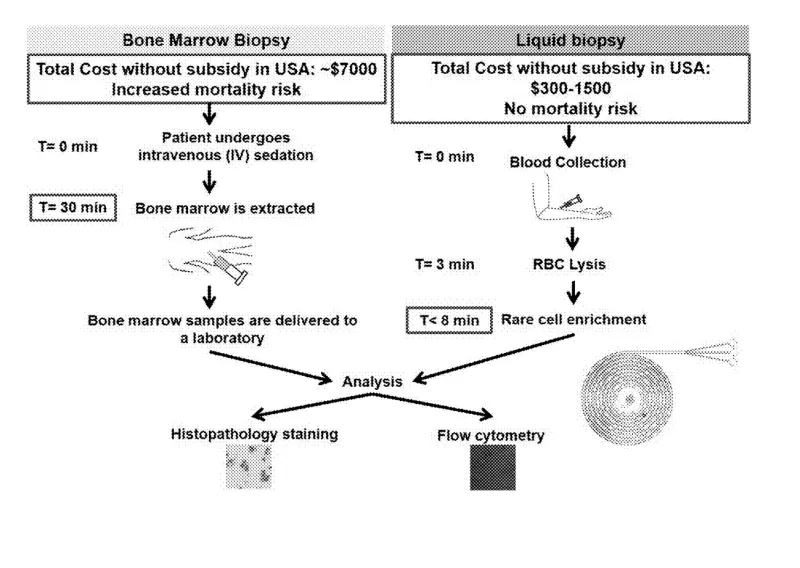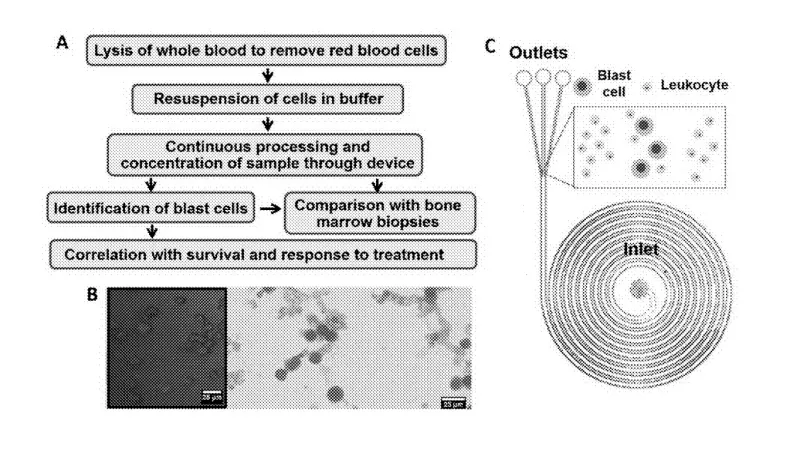Liquid Biopsy Detection of Minimal Residual Disease in Leukemia Using Closed-Loop Microfluidics
This technology is a closed-loop microfluidic system that enriches for leukemic blast cells from blood with applications in the medical field for the detection of minimal residual disease in leukemia patients.
Researchers
-
liquid biopsy detection of leukemia using closed-loop microfluidics
United States of America | Granted | 10,697,964
Figures
Technology
Using an inertial focusing approach, this technology detects rare leukemic blast cells from blood samples. A patient’s blood sample is first collected, and red blood cells are lysed. The sample is then loaded into the inlet reservoir of a microfluidic biochip. Here, a net force that is comprised of net internal lift force and dean drag force is exerted onto the blood sample in a closed-loop spiral microchannel. Non-target cells, such as white blood cells, encounter a different net force than blast cells, which have a higher nuclear-to-cytoplasmic ratio. The differential net force allows distinct cell types to form separate focused streams within the microchannel. Strategically placed bifurcation points within the microchannel enable the sorting of cells undergoing differential net forces into separate outlet reservoirs. The isolated blast cells can then be further evaluated by flow cytometry and histopathology.
Problem Addressed
The non-invasive detection of leukemia could enable clinicians both to treat this disease earlier in its development and to monitor residual disease, thus improving overall prognosis of leukemia patients. Leukemia can be detected most directly by collecting a biopsy of the patient’s bone marrow. However, this surgical procedure is expensive and invasive, and is unsuitable for the long-term management of leukemia. A non-invasive alternative to bone marrow biopsy would involve sampling the patient’s blood to detect myeloid blast cells, which are leukemia cells that have been released from the bone marrow and have entered the circulatory system. Unfortunately, existing methods such as flow cytometry are not sensitive enough to detect rare blast cells in patients that have minimal residual disease. For leukemia patients with minimal residual disease, an effective non-invasive method to detect rare blast cells in the blood could prevent cancer relapse and improve quality of life.
The present invention can isolate and concentrate rare blast cells from liquid biopsies using a novel closed-loop microfluidic technique to monitor leukemia patients and improve therapeutic success.
Advantages
- Non-invasive technique enables routine monitoring of leukemia
- Significantly less expensive and faster than bone marrow biopsy with no mortality risk
- No need for antibody labeling to isolate cancer cells
Publications
Khoo, B.L., et al. (2019). Liquid biopsy for minimal residual disease detection in leukemia using a portable blast cell biochip. npj Precis. Onc. 3, 30. doi: 10.1038/s41698-019-0102-5.
License this technology
Interested in this technology? Connect with our experienced licensing team to initiate the process.
Sign up for technology updates
Sign up now to receive the latest updates on cutting-edge technologies and innovations.

